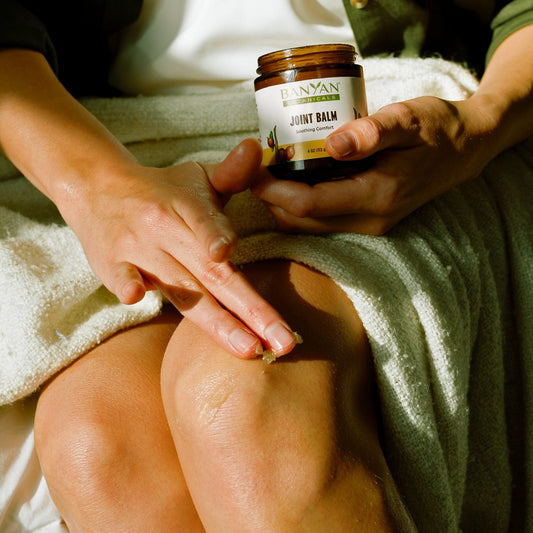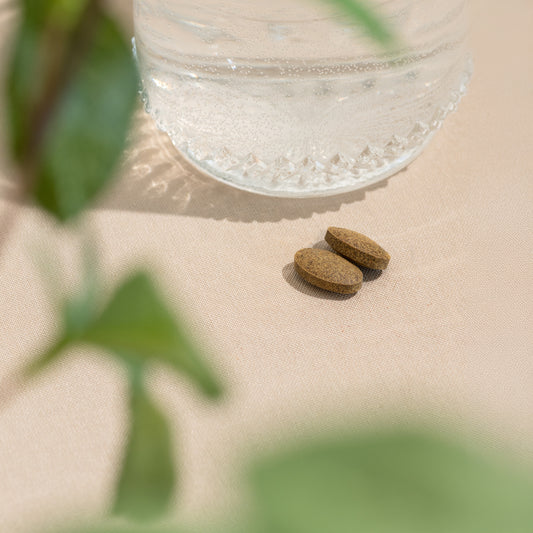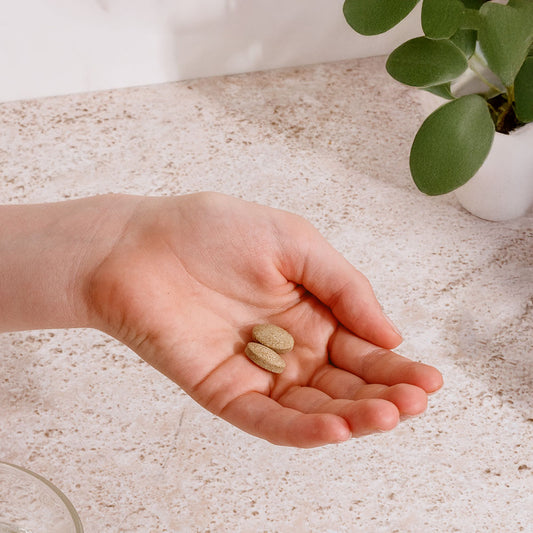A Pitta-Balancing Approach to Fitness

Pitta is slightly less delicate than vata, but more so than kapha, with moderate stamina. Qualitatively, pitta is hot, sharp, light, oily, liquid, spreading, and clear, which means that pitta has a fair amount in common with exercise.
In this article:
- Pitta and Exercise: A Qualitative Comparison
- How to Balance Pitta with Exercise
- Additional Practices to Support Your Body
- Embrace What's Right for You
If like increases like, this means that, particularly for those of us who have a lot of pitta in our constitutions or who are currently dealing with a pitta imbalance, exercise has a strong potential to exacerbate the situation—especially if we approach our activities in a pitta-aggravating way.
The solution lies in making more conscious and intentional choices that help keep the system cool and calm while grounding and soothing pitta—making exercise a win-win.
The best way to do this is to start paying attention to the various qualities that we can bring into our fitness routines and into our lives—and begin to favor those that will promote balance.
Pitta and Exercise: A Qualitative Comparison
| Qualities of Pitta | Qualities of Exercise | Balancing Qualities |
| Fire + Water | Air + Fire | Earth |
| Hot | Hot | Cold |
| Sharp | Sharp | Slow/Dull |
| Light | Light | Heavy (Grounding) |
| Spreading | Mobile | Stabilizing |
| Clear | Clear | Substantive |
| Oily | Dry | N/A |
| Liquid | N/A | N/A |
How to Balance Pitta with Exercise
In general, a pitta-balancing approach to physical activity should be grounding and moderately-paced, should avoid significant accumulations of internal heat, and should aim to steer clear of overly competitive attitudes.
For pitta, it is important to avoid exercising from 10–2 a.m./p.m., when the qualities of pitta are elevated in the natural world. While exercising at the kapha time of day (from 6–10 a.m./p.m.) is certainly the most supportive, any time outside of the mid-day period helps minimize one's exposure to heat and other pitta-aggravating qualities.
Movements should be appropriately challenging, but executed in a relaxed manner (without strain), should emphasize fluidity (which counters pitta's sharpness and rigidity), and should feel stabilizing and pleasantly nourishing.
Focus on bringing as many of the following influences into your workouts as possible:
Relaxed Effort. This is pitta's key to success. Pitta is naturally aligned with ambition and strength of character. With a lot of pitta in your system, you may quite enjoy a good challenge, and you may know your iron will to be capable of pushing through every imaginable obstacle.
Unfortunately, taken too far, this mentality often comes at the expense of the body's physical needs, and pitta is actually far more delicate than a pitta mind likes to admit. Thus, it is essential to balance pitta's capacity to overcome adversity (along with its natural desire to get it “right”) with an intention to relax.
Surrendering to a space of enjoyment—even when working hard physically—can make a huge difference. This is about softening pitta's sharpness and intensity, rounding out the experience, and inviting a little more fun and pleasure into your workouts (and your life, in general).
It is absolutely fine—important even—to challenge yourself physically, as long as the mental and emotional spheres are more soft and spacious than they are sharp.
Groundedness. Make a conscious effort to develop a connection with the earth element. Because of its inherently grounding nature, the earth can be tremendously supportive as you exercise.
Activities that help us connect with the earth include:
- Lying down—either on a firm floor or (when weather permits) outside, directly on the earth.
- Placing the feet purposefully on the floor (or ground, when outdoors) and directing your full attention toward the connection between the feet and the earth.
- Exercising outdoors and in nature, and specifically inviting your senses to fully receive the natural world around you.
- Always practicing yoga barefoot.
- Embracing standing, balancing, and supine poses in your yoga practice to more purposefully connect with the earth, and closing your practice with several minutes in Savasana (Corpse Pose).
Fluidity. Pitta's sharp, willful way of navigating the world can cause a lot of tension. Bringing a smooth fluidity to your movements helps counter these tendencies, and invites a sense of grace and ease into the system.
For example, tai chi and swimming are far more fluid and pitta-balancing forms of exercise than bodybuilding.
In any activity, try using the breath to create a sense of freedom and flow throughout the body, and explore alternative ways of moving that break your entrained patterns. (The yoga pose Cat-Cow illustrates beautifully how this might be accomplished.)
Flexibility. Much like fluidity, cultivating flexibility can help release unnecessary tension or tightness. Be sure to stretch before and after your workouts in order to prevent undue strain or constriction. And use the breath to encourage the release of unnecessary tension.
Rest and Rejuvenation. Pitta is also deeply supported by balancing periods of activity with adequate rest and recovery. If you are a committed athlete, consider taking a day off between your more intense workouts, or at least alternating them with more gentle activities.
Also, in conjunction with adapting how you exercise, be sure to offer your body plenty of pitta-soothing qualities outside of your exercise regimen.
Exceptionally Balancing Activities. Given the qualitative nature of pitta-balancing exercise, some activities are naturally more balancing than others.
If you are unattached to a particular form of exercise, consider brisk walking, hiking, tai chi, swimming, jogging, cycling, skiing, snow-shoeing, and pitta-balancing yoga.
If you are embarking on a new exercise routine, keep in mind that it need not be complex or time-intensive. Even a daily twenty-minute walk can be incredibly supportive for your entire being—body, mind, and spirit.
On the other hand, if you are already in the habit of practicing a form of exercise that you love, do your best to do it in a pitta-friendly way. And if the activity tends to be inherently pitta-aggravating, be sure to bring some additional support for pitta into other areas of your life.

Additional Practices to Support Your Body
As you might imagine, the exercise itself isn't all that matters. Any regular influences that help ground pitta systemically can help support your overall sense of balance and can even serve to counteract some of the more aggravating aspects of exercise, ensuring that you reap the full benefits of being active.
Consider the suggestions below, and if you want more, please explore our resource on creating a Pitta-Balancing Daily Routine.
Calm and Quiet the Mind
Anything you can do to keep the pitta mind cool, calm, and quiet helps balance pitta systemically.
- Consider a few minutes of Empty Bowl Meditation.
- Experiment with the impact of lying in Savasana for a few minutes each day.
- Or commit to a regular daily practice of pranayama (yogic breathing exercises). Full Yogic Breath, Nadi Shodhana, and Sheetali are especially soothing for pitta.
Whichever of these practices speak to you, know that even five to fifteen minutes per day can be transformative.
Nourish Yourself: Body, Mind, and Spirit
Appropriate nourishment can take many forms—all of which serve to counter pitta's light, spreading, and clear qualities by grounding, stabilizing, and providing substance to the system.
- Pitta thrives on a nutritive diet of healthy, whole foods. It can also be quite impactful to eat mindfully—to bring conscious awareness to the act of receiving nourishment, and to cultivate gratitude for that process.
- Of course, the pitta mind craves nourishment as well, so finding ways to engage the mind that are relaxing, enjoyable, and that feel nutritive to us can serve a similar purpose. And the same goes for our spiritual cravings.
- Finding ways to nourish the soul with meaning and purpose—in ways that bring stable, grounding, and substantive energies into your experience is an equally valid form of nourishment.
Whether you choose to focus on one of these areas or all three, the effect is sure to be pleasantly pitta-balancing.
Pamper Your Muscles
The muscular system is inherently active during exercise and requires proper rest and recovery in order to maintain optimal health and integrity. You might consider offering your muscles a little extra care with regular massage, steam baths, Epsom salt baths, or with the application of soothing topical rubs like Muscle Balm.
Prioritize Rejuvenation
Ayurvedic rejuvenation is the process of offering deep nourishment to the tissues, and is a particularly potent way of nourishing the system. Adding a rejuvenative to your daily routine can be particularly supportive in balancing the inherently lightening influences of exercise.
Consider taking a teaspoon of Chyavanprash each morning about thirty minutes before breakfast. Or explore our rejuvenation department for additional ideas.
Slow Your Pace and Enjoy Yourself
Slowing down and taking pleasure in the unfolding of each moment softens pitta's sharpness and intensity. Making this a regular practice is a great way to embrace relaxed effort throughout your life.
Embrace What's Right for You
At the end of the day, Ayurveda is a tradition that encourages each of us to embrace our uniqueness. Your path toward balance should be appropriately tailored for what you need, who you are, and also what will work best for you.
Exercise is simply another area of our lives where we can use the wisdom of Ayurveda to support our overall health and well-being. If like increases like and opposites balance, there are countless ways to introduce balancing energies into our fitness routines (and our lives).
Your task is to find your way. Make this journey your own. Experiment with what speaks to and nourishes you, and celebrate this opportunity to bring more support and inspiration into your life.
About the Author
Melody Mischke, AP
Melody Mischke is a certified Transformational Coach, Ayurvedic Practitioner, Yoga Teacher, Writer, and Intuitive. She began studying meditation in India at 18, and has...
More for You
Pitta Balancing Daily Routine
Adopting a daily routine is a very purposeful and enduring act of self-love. Each day, our routines provide us with a tangible opportunity to prioritize our own health and wellbeing, regardless of what else might be going on in our lives. Read on for specific practices for pitta-predominant individuals.
Pitta-Balancing Diet
Pitta is balanced by a diet of fresh, whole foods (both cooked and raw) that are cooling, hearty, energizing, comparatively dry, and high in carbohydrates.














